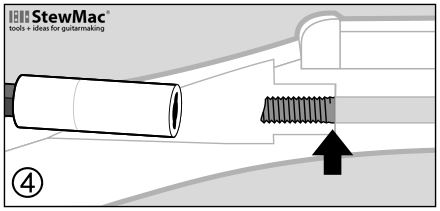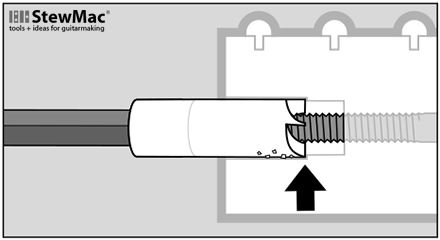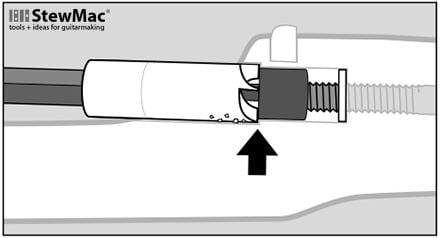Truss Rod Rescue Tools Set Instructions
Broken truss rod? Don't scrap that neck, rescue it!
- Rescues truss rods when the adjusting nut has broken off
- Removes wood to access unused truss rod
- Restores damaged threads
- Cuts new threads
Tools included:
#6190 Hex wrench
T-handle design gives precise control for turning the wood cutter and thread-cutting dies.
#6204 Pilot bit for Fender bullet
Guides the 3/8" cutter into the smaller access hole on Fender necks with bullet adjusters.
Truss rod extension nuts for Fender
These come in three sizes:
#6197 8-32 thread
#6198 10-32 thread
#6199 10-24 thread
Wood cutters
These compact (3/8"-diameter) cutters remove a tiny amount of wood, exposing the truss rod for cutting additional threads.
There are two sizes:
#6194 For 8-32 thread rods commonly used on Fender
#6195 For 10-32 and 10-24 thread rods used on Gibson and Fender
Steel spacers
Spacers provide a smooth surface for the truss rod nut to bear against, and cover the last bit of partial thread left by the die. Spacers are .365" diameter, with a .195" bore. We provide them in three thicknesses:
#6200 .040" thick for vintage Fender heel-adjust necks
#6201 .100" thick for Gibson necks
#6202 .200" thick for Gibson necks that need a thicker spacer
Thread-cutting dies
These metal-cutting dies clean up existing threads and add new thread. They come in three sizes:
#6191 8-32 thread for vintage Fender (approximately ’60-mid ’64)
#6192 10-32 thread for Gibson (all years) and vintage Fender (approximately mid ’64 through the 70s, and US-made vintage reissues)
#6193 10-24 thread cutting die for vintage Fender (approximately ’54-’59)

Good, working truss rod. This adjusting nut is accessible, turns without too much force, and is flush against a metal washer that serves as a bearing surface.

Broken truss rod. Here, the adjusting nut has frozen to the truss rod and then broken off—taking part of the rod away with it. The remaining truss rod doesn't have enough thread exposed for an adjusting nut.
Use the Truss Rod Rescue Tools to repair standard truss rods. They fit the standard single action truss rods commonly used on Gibson and Fender guitars, mandolins, banjos, as well as some others. One end of the rod is anchored inside the neck, and the other end is threaded to accept an adjusting nut. Tightening the adjusting nut pulls the rod tight, which pulls the neck. The threaded end is where a truss rod is most likely to fail: threads become damaged, and sometimes rods break at this point. This is where the Truss Rod Rescue Tools help by cutting wood to expose more of the rod, and cutting new threads into the exposed rod. Sometimes the adjusting nut is located in the peghead, and sometimes in the heel of the neck. The Truss Rod Rescue Tools work in either situation. Fender truss rods: If your damaged Fender truss rod doesn’t have enough exposed thread to measure, here’s a guide. If the rod diameter is around 3/16" and the guitar was made before 1960, the thread is most likely 10-24. If the guitar is from after mid-‘64 the thread will be 10-32. If the Fender rod diameter is around 5/32", which was used around 1961-64, the spec will be 8-32.
Broken truss rods: In some cases the nut will have broken off, taking the end of the truss rod with it. To repair a truss rod in this condition requires removing wood around the rod, and cutting new threads. See the next page for step-by-step instructions.
Maxed-out threads: Sometimes a truss rod can no longer adjust because there aren't enough threads left on the rod to do the job. In these instances, you can follow the same procedure for repairing a broken rod to add more threads to the rod and allow further adjustment.
Damaged threads: First try cleaning the threads. Turn the truss rod’s adjusting nut counterclockwise to remove it from the threaded rod. Sometimes, all that’s needed is a cleanup of the truss rod threads. Use the thread-cutting die for this, turning it carefully onto the existing threads. By threading the die on and off once, you’ll know the rod is cleaned and ready for its adjusting nut.
If you feel resistance when turning the die, stop. This resistance means the tool has met with marred or dirty threads, or is starting to cut new threads in the metal rod. This requires a slow and careful approach, as detailed in Step 3.
Truss rod repair for Gibson and others

Step 1 Use the cutter to remove wood until you have
exposed about 13/32" of the truss rod. (Depending on the damage, you may need to remove more wood.) Use only moderate pressure, and let the tool do the cutting. Stop frequently to remove wood chips from the cavity.

Step 2 With the wood removed you now have access to more of the truss rod, but there may not be enough thread for the adjusting nut.

Step 3 Switch to the die, using it carefully so you can feel it catch onto the threads. If damaged threads make it difficult to engage the die, use our #6196 Chamfering Tool to remove burrs and put a clean end on the rod.
Turn the die slowly, and stop when it hits resistance. Note the position of the wrench at this point, then continue a quarter turn—you’ve now started cutting threads. After the initial quarter turn, back the die out and clean its threads. Also clean any shavings from the truss rod cavity. Continue thread-cutting a quarter turn at a time, stopping to clean between each cut until you reach the bottom of the cavity. Cutting too quickly allows shavings to build up and places stress on the truss rod. A bit of lubricant in the die, such as petroleum jelly, Guitar Grease, Tap-Ease, paraffin, or beeswax will ease the job and produce cleaner threads. We don’t recommend using oil, or any other thin lubricant that might leech into the wood.

Step 4 Now there is enough thread for the adjusting nut, but the die leaves a little bit of unthreaded rod at the deepest point in the cavity.

Step 5 Use a spacer to cover that last bit of unthreaded rod and to provide a metal bearing surface. On Fender necks, use the .040" thick spacer. Gibson guitars generally will need a .100" thick spacer. In some cases, the .200" thick spacer will be needed.

Fender heel-adjust truss rods
On Fender necks with an adjusting nut at the heel end, the truss rod threads extend approximately 1-1/4". When these rods break, it’s usually where the adjusting nut meets the strike washer. This leaves plenty good thread to be uncovered and used.
For these, you need to remove the strike washer from around the truss rod. A scribe or micro-chisel works well for this. Then use the wood cutter to expose about 7/16" of fresh threads. Clean up the threads with the appropriate die, and install a thin (.040") spacer.
Now that the truss rod cavity is deeper, a longer adjusting nut will be needed. StewMac offers the following Truss Rod Extension Nuts for Fender:
#6197 8-32 thread
(used from approximately 1960 through mid-1964)
#6198 10-32 thread
(mid-1964 through the 1970s, and US-made vintage reissues)
#6199 10-24 thread
(used from approximately 1954-1959)
Use the pilot for Fender bullet truss rods
Some Fender necks have a bullet truss rod nut at the peghead. These have a slightly narrower truss rod cavity. To center the wood cutter on these, we provide a brass pilot bit. Inserted in the cutter, this pilot keeps the cutter centered until the cut is well started; after that you can remove the pilot and continue cutting normally.





